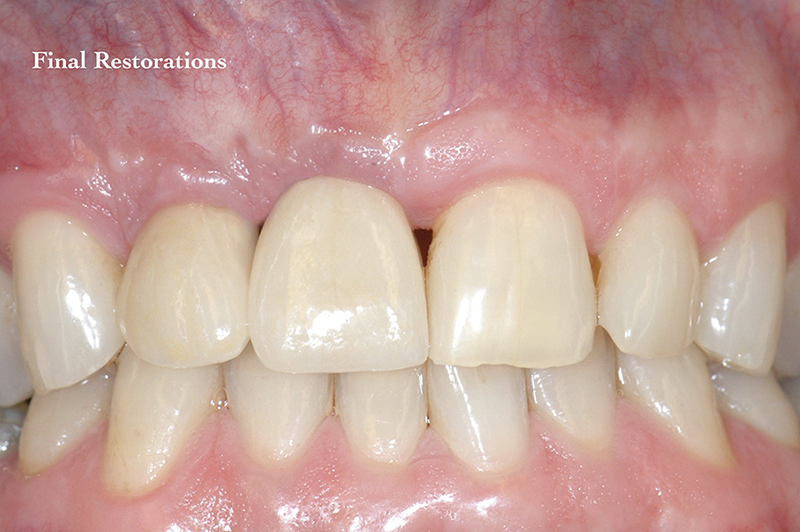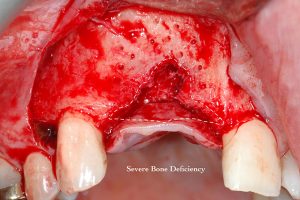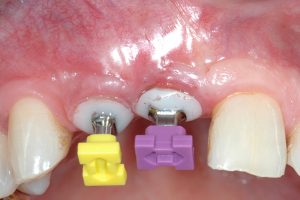
Treatment: Implant treatment for tooth loss from periodontal disease
Shaun was referred to our clinic for assessment of localized periodontal disease with significant bone loss. This had been an ongoing localized issue for a number of years and periodic non-surgical therapy had proven ineffective. The bone loss had slowly deteriorated. Two front teeth had become progressively more mobile and extruded, the gums had receded giving a “long in the tooth” appearance. The splayed teeth were uncomfortable to eat with, had periodic bouts of acute infections (abscess), and had become unsightly.
Periodontal disease is the leading cause of tooth loss. Periodontitis is an inflammatory infectious disease process that causes destruction of the supporting structures of the tooth, bone support, and overlying gum tissues. Most adults over the age of 45 exhibit some degree of periodontal disease but in majority of cases the condition is treatable. Treatment aims at arresting the progression of the disease as well as regenerative procedures that regain lost structures. In some advanced forms of the disease, removal of the affected tooth (teeth) remains the only option for arresting progression.
Shaun's words via his Yelp review
“I'm extremely grateful for being referred to Portland Perio Implant Center. Dr. Haghighat and his staff are professional, comforting and genuinely friendly.
My treatment plan, procedures and resulting expenses were explained in detail and remained accurate throughout the process. I remain very satisfied with the entire experience!”
Tooth replacement in the esthetic zone with dental implants is a challenging procedure to execute correctly. An Ideal esthetic outcome in implant restoration where multiple adjacent teeth are missing and the volume of bone and soft tissues are deficient is particularly difficult to achieve. The natural remodeling of bone and soft tissues after tooth removal makes maintenance of the inter-implant papilla (gums that fill in between the teeth) especially a formidable task. Therefore, multiple procedures and protocols are often necessary to address the deficient bone and soft tissue architecture prior to and after implant placement.
In Shaun’s case, all esthetic concerns were valid and these were clearly communicated. The plan for dental rehabilitation and replacement of the diseased teeth should follow sound clinical parameters to maximize the likelihood of producing ideal esthetic results. A period of 12 months is typically the duration for therapy in such complex scenarios.
As Shaun prepared for his journey, a great deal of patience was needed to arrive at the desired end-point. A thorough clinical evaluation including a 3D cone beam scan and other diagnostic parameters were used to arrive at a correct diagnosis and formulate an appropriate treatment plan. Our comprehensive assessment revealed a poor short and long-term prognosis for both upper teeth involved and extraction of the diseased teeth was recommended.
Once the teeth were removed, a temporary removable appliance was provided in the interim to allow for tissue healing. This gave us a better indication of the degree of tissue deficiency that had to be reconstructed. Bone augmentation of the alveolar defect was done under conscious sedation and 4 months later, the foundation for 2 implants was completed. A soft tissue graft was performed simultaneously at implant placement to further enhance the esthetics of future restorations.
"Most adults over the age of 45 exhibit some degree of periodontal disease, but in the majority of cases the condition is treatable."
DR. KAMRAN HAGHIGHAT, B.D.S., M.S., P.C.
The Implant integration was successful. Next steps were to optimize the soft tissue characterization and form and to recreate an anatomically-shaped tissue profile in harmony with the remainder of the smile. Temporary crowns were fabricated and placed on the implants. These were maintained until maximum achievable reshaping of the tissues was accomplished. Individual final crowns were then fabricated and delivered. Following sound clinical concepts will improve the predictability of achieving an esthetic result and will provide long-term peri-implant tissue stability.
Thank you, Shaun, for your patience and trust in us through this journey back to a healthy and confident smile.















